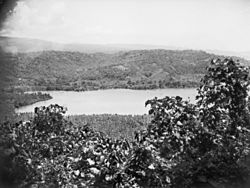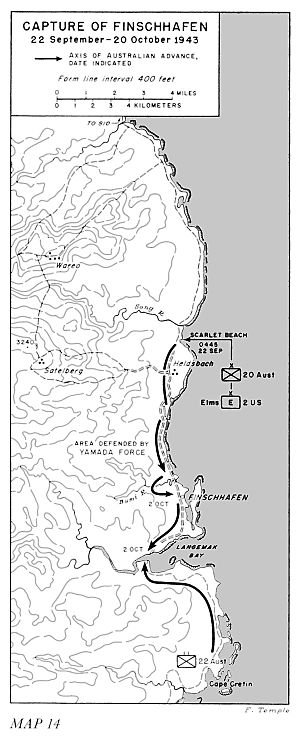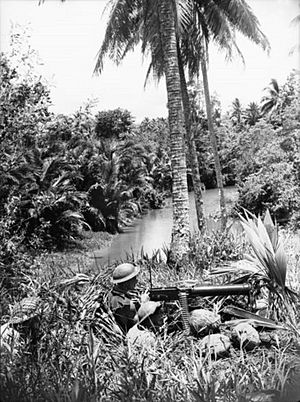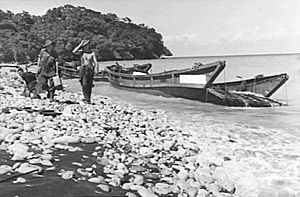Battle of Finschhafen facts for kids
Quick facts for kids Battle of Finschhafen |
|||||||
|---|---|---|---|---|---|---|---|
| Part of World War II, Pacific War | |||||||
 A view of Finschhafen, October 1943 |
|||||||
|
|||||||
| Belligerents | |||||||
| Commanders and leaders | |||||||
| Hatazo Adachi Eizo Yamada Shigeru Katagiri |
|||||||
| Units involved | |||||||
|
|
||||||
| Strength | |||||||
| ~5,300 (first phase) | 4,000 – 5,000 (first phase) ~ 12,000 (second phase) |
||||||
| Casualties and losses | |||||||
| 73 killed, 285 wounded (first phase) 49 killed, 179 wounded (second phase) |
679 killed, 821 wounded (second phase only) | ||||||
The Battle of Finschhafen was a key fight during World War II in New Guinea. It was part of the larger Huon Peninsula campaign. Australian and Japanese forces fought fiercely for control of the important town of Finschhafen.
The battle took place from September 22 to October 24, 1943. Australian troops landed at Scarlet Beach and then pushed towards the town. Another Australian group advanced from the south. After capturing Finschhafen, the Japanese tried to take it back with a big counterattack. However, Australian and American forces stopped them. This victory allowed the Allies to continue their advance in New Guinea.
Contents
Why Finschhafen Was Important
Finschhafen was taken by the Japanese army in March 1942. They used it to protect their air base at Lae. In 1943, the Allies (Australia and the United States) began to push back. After capturing Lae, they aimed for Finschhafen.
Controlling Finschhafen was very important. It would allow the Allies to build airfields and naval bases. These would be used for future attacks, especially in the New Britain campaign. Major General George Wootten's Australian 9th Division was given the job of securing this area.
On September 22, 1943, the Australian 20th Infantry Brigade landed at Scarlet Beach. This beach was about 10 kilometers (6 miles) north of Finschhafen. At the same time, the 22nd Infantry Battalion marched from the south. They had landed east of Lae earlier in September.
The Japanese knew the Allies would attack Finschhafen. Lieutenant General Hatazo Adachi sent more troops to the area. These included soldiers from the 20th, 41st, and 51st Divisions. In total, there were about 4,000 to 5,000 Japanese soldiers. They set up defenses around Sattelberg, a mountain about 12 kilometers (7.5 miles) northwest of Finschhafen. The Japanese faced problems with supplies and transport. Their commander, Major General Eizo Yamada, was ordered to delay the Australians.
The Battle Begins
Australian Advance on Finschhafen
After landing, the Australians set up a secure area around Scarlet Beach. They fought hard battles at Siki Cove and Katika. On September 23, the 20th Brigade began its push towards Finschhafen. Two battalions led the way, supported by artillery and engineers. Other troops secured the beachhead and pushed towards Sattelberg.
The Australians faced tough challenges. The jungle was thick, with many rivers and hills. They had few vehicles, so soldiers had to carry many supplies. Local people, who might have helped carry things, had left the area.
The Australian advance captured the Heldsbach plantation and a nearby airfield. They met strong Japanese resistance at the Bumi River. About 300 Japanese sailors and marines, plus other soldiers, held this position. They fought hard, stopping the Australian advance on September 26. But the Australians eventually outflanked them and pushed forward.
The Australian commander, Brigadier Victor Windeyer, asked for more troops. He was worried about the large number of Japanese soldiers. At first, the request was denied. US naval commanders feared losing ships. Also, Allied leaders mistakenly thought there were only a few Japanese defenders. In reality, the two sides were about equal in strength.
After more talks, the 2/43rd Infantry Battalion arrived on September 29-30. They helped defend the beachhead. Heavy rain made it even harder to move supplies. The 2/17th Battalion fought off several Japanese attacks around Jivevaneng. These attacks were attempts by the Japanese to reach the coast.
The Australians also pushed cautiously towards Kakakog. They used artillery and air attacks to weaken Japanese defenses. From the south, the 22nd Infantry Battalion advanced with less resistance. On October 1, they crossed the Mape River. The 20th Infantry Brigade also defeated a Japanese force at Kakakog.
The Japanese then began to pull back from Finschhafen. On October 2, the 20th Infantry Brigade reached their goal. They entered Finschhafen in the afternoon after facing little resistance. The two Australian forces met up the next day.
This marked the end of the first part of the battle. The Australians lost 73 soldiers killed and 285 wounded. Many also got sick. The Japanese suffered heavy losses. However, many Japanese soldiers had escaped to the west, ready for more fighting.
Japanese Counterattack
After Finschhafen was captured, most of the Australian 20th Infantry Brigade returned to Scarlet Beach. They expected a Japanese attack. The 2/13th and 22nd Battalions stayed in Finschhafen. Other units prepared to defend Scarlet Beach.
Around Jivevaneng, the 2/43rd Battalion stopped a Japanese attack. On October 5, the Japanese responded fiercely when their supply lines were threatened. The 2/17th Battalion fought hard around Jivevaneng. On October 10, they captured a high point called "the Knoll." They then fought off 12 Japanese attacks to keep it.
On October 10-11, Allied leaders realized a major Japanese attack was coming. More Australian troops arrived, including the 24th Infantry Brigade. The main part of the Japanese 20th Division also arrived. The Japanese force now numbered about 12,000 soldiers.
The Australians found a Japanese briefcase with battle plans. They also intercepted radio messages. This allowed them to prepare for defense instead of pushing forward.
The main Japanese counterattack began on October 16. It was planned as a three-part attack. One part was a small attack to distract the Australians. Another was a sea landing on Scarlet Beach. The main attack would come from Sattelberg, aiming for Scarlet Beach and Heldsbach.
But the Japanese plans quickly went wrong. The distraction attack failed. The main attack started too early. The sea landing also suffered badly. More than half of the Japanese landing craft were destroyed by US patrol boats. The Japanese who made it to the beach faced strong defense from US and Australian troops.
A brave American soldier, Private Nathan van Noy, fought fiercely. He and Corporal Stephen Popa used a machine gun against the Japanese. Even after a grenade wounded van Noy, they kept firing. Another grenade silenced them. Van Noy was later awarded the Medal of Honor for his bravery.
The Australians held key areas like Jivevaneng and Katika. They used their artillery and air support to cause heavy Japanese losses. However, on October 18, some Japanese broke through to Siki Cove. Australian gunners had to fight them with small arms. That night, the Japanese cut off the Australian supply route to Jivevaneng. Some Australian units became isolated behind Japanese lines.
Supplies were dropped by air to these isolated troops. Despite some confusion, the Australians fought back. The 2/28th Infantry Battalion, supported by artillery, successfully recaptured Katika.
The Japanese attack eventually stopped. They had suffered greatly due to poor planning and lack of artillery. The Allies also faced challenges, including disagreements between Australian and US commanders. They also underestimated the Japanese strength at first. By October 24, the attack was called off. The Japanese lost at least 679 killed and 821 wounded. The Australians lost 49 killed and 179 wounded.
What Happened Next
After stopping the Japanese counterattack, the Allies prepared to attack the main Japanese position at Sattelberg. Australian and American forces began working more closely. More troops arrived, including the 26th Infantry Brigade. A squadron of Matilda tanks also arrived, kept secret from the Japanese.
Supplies were brought up to Jivevaneng and Kumawa. Heavy rain made this difficult. The Australians then slowly advanced through the dense jungle towards Sattelberg. They fought hard, using the Matilda tanks to help. They eventually captured the strong Japanese position.
Other Allied actions continued. The 7th Division advanced inland to cut off Japanese escape routes. After Sattelberg was secure, the Allies cleared the Wareo plateau. This area was important for observing Scarlet Beach and for Japanese communications. Once Wareo was secure, the Allies moved along the coast towards Sio. US forces also landed at Saidor to follow the retreating Japanese.
Finschhafen became a very important Allied base. It grew into "one of the largest bases in the Southwest Pacific area." It had a large camp, a wharf, and ramps for landing ships. Several airfields were built for fighter and bomber planes. From Finschhafen, the Allies could launch air attacks on the main Japanese base at Rabaul. It also helped control important sea passages. The base was crucial for supplying American forces as they advanced through the Philippines.
In 1961, the Australian Army units involved in the battle were honored with the "Finschhafen" battle honor. This honor covered the period from September 22 to December 8, 1943.
Images for kids





